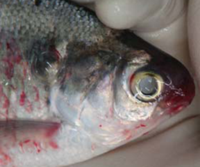
Photo from wikipedia
The outbreaks of viral hemorrhagic septicemia (VHS) and viral encephalopathy and retinopathy (VER) caused by the enveloped novirhabdovirus VHSV, and the non-enveloped betanodavirus nervous necrosis virus (NNV), respectively, represent two… Click to show full abstract
The outbreaks of viral hemorrhagic septicemia (VHS) and viral encephalopathy and retinopathy (VER) caused by the enveloped novirhabdovirus VHSV, and the non-enveloped betanodavirus nervous necrosis virus (NNV), respectively, represent two of the main viral infectious threats for aquaculture worldwide. Non-segmented negative-strand RNA viruses such as VHSV are subject to a transcription gradient dictated by the order of the genes in their genomes. With the goal of developing a bivalent vaccine against VHSV and NNV infection, the genome of VHSV has been engineered to modify the gene order and to introduce an expression cassette encoding the major protective antigen domain of NNV capsid protein. The NNV Linker-P specific domain was duplicated and fused to the signal peptide (SP) and the transmembrane domain (TM) derived from novirhabdovirus glycoprotein to obtain expression of antigen at the surface of infected cells and its incorporation into viral particles. By reverse genetics, eight recombinant VHSVs (rVHSV), termed NxGyCz according to the respective positions of the genes encoding the nucleoprotein (N) and glycoprotein (G) as well as the expression cassette (C) along the genome, have been successfully recovered. All rVHSVs have been fully characterized in vitro for NNV epitope expression in fish cells and incorporation into VHSV virions. Safety, immunogenicity and protective efficacy of rVHSVs has been tested in vivo in trout (Oncorhynchus mykiss) and sole (Solea senegalensis). Following bath immersion administration of the various rVHSVs to juvenile trout, some of the rVHSVs were attenuated and protective against a lethal VHSV challenge. Results indicate that rVHSV N2G1C4 is safe and protective against VHSV challenge in trout. In parallel, juvenile sole were injected with rVHSVs and challenged with NNV. The rVHSV N2G1C4 is also safe, immunogenic and efficiently protects sole against a lethal NNV challenge, thus presenting a promising starting point for the development of a bivalent live attenuated vaccine candidate for the protection of these two commercially valuable fish species against two major diseases in aquaculture.
Journal Title: Frontiers in Immunology
Year Published: 2023
Link to full text (if available)
Share on Social Media: Sign Up to like & get
recommendations!